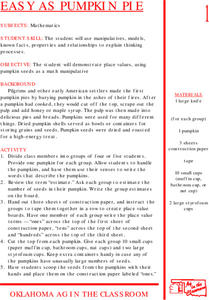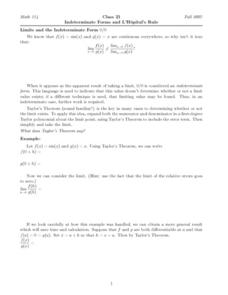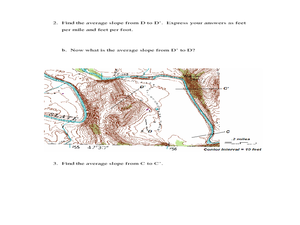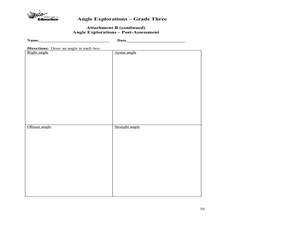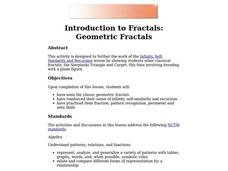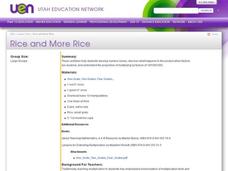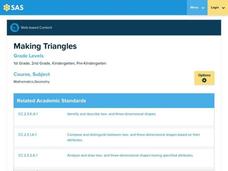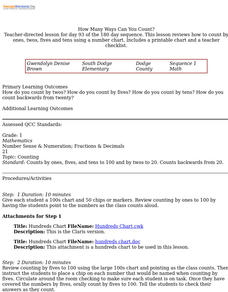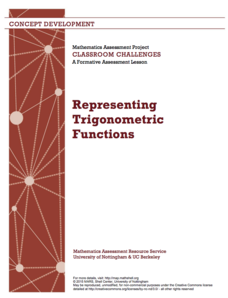Curated OER
Transformations and Exponential Functions
Tenth graders study graphing exponential functions. In this transformations lesson, 10th graders apply inquiry to determine how changes to a parent function affect its graph. Students analyze transformed graphs and generate the function...
Curated OER
EASY AS PUMPKIN PIE
Students demonstrate place values using pumpkin seeds as a math manipulative. They use manipulatives, models, known facts, properties and relationships to explain thinking processes. They estimate the number of seeds in their pumpkin.
Curated OER
Indeterminate Forms and L'Hopital's Rule
In this limits worksheet, students use Taylor's Theorem to solve two short answer problems. They use L'Hopital's Rule to solve two short answer problems. Students read a two page lesson on limits.
Curated OER
Slope and Topographic Maps
Students investigate slopes as they study topographic maps. In this algebra instructional activity, students discuss and apply the concept of slopes to graphing and analyzing data.
Curated OER
Angle Explorations
Third graders observe angles in their classroom and create an angle finder to represent them.In this angles lesson, 3rd graders classify angles as acute, obtuse, right or straight. Students find the differences and similarities in angles.
Curated OER
Explore the Ocean
Students explore the oceans from their origin. In this oceans lesson, students read and discuss excerpts from the Book of Genesis regarding the creation of the ocean. Students then clean up a mock oil spill, measure the volume and area...
Curated OER
Introduction to Fractals: Geometric Fractals
Students study and observe the patterns made by the areas of the Sierpinski Triangle. Students use the computer to draw two or three iterations to discover the number patterns. Students complete worksheets based on Geometric Fractals.
Curated OER
The Golden Ratio
Seventh graders investigate a ratio found in nature and in numerous pieces of artwork throughout history. The lesson is cross-curricular and builds a sense of appreciation of design for students.
Curated OER
Going out of Business: Pythagorean Theorem
Students find the length of diagonals. In this Pythagorean theorem lesson, students use the Pythagorean theorem to determine the length of diagonals.
Curated OER
Money: Kids and Cash
Students discuss what a bank is and what it is used for. In this mathematics lesson, students solve problems related to interest and percentages.
Curated OER
Ravishing Rings (Multiplication with a Snack)
Learners understand multiplication through the use of snack manipulatives. In this multiplication lesson, students solve a multiplication problem using pretzels and then create and answer original problems. Learners analyze how they got...
Curated OER
Rice and More Rice
Fifth graders explore problem solving strategies for mathematical estimation. In this math problem solving instructional activity, 5th graders predict how many grains of rice are in a jar, practice establishing and looking for patterns...
Curated OER
A Famous Home
For this White House math worksheet, students read a fact about the White House and circle the number (out of 3 choices) that makes the most sense. Example: The White House is 3, 30, or 300 floors tall.
Curated OER
Spatial Connections
Students use maps, scales, and describe locations in order to learn about spatial sense. In this spatial sense lesson plan, students participate in many activities for this spatial sense unit that should last throughout the year.
Pennsylvania Department of Education
Making Triangles
Students use interactive geoboards to identify simple geometric shapes. In this making triangles lesson, students describe the properties associated with geometric shapes. Students develop spatial sense and the mathematical meaning...
Curated OER
Addition Properties
Student study addition properties. For this addition properties lesson, young scholars use multiple methods to solve various types of problems. Students illustrate and describe in various ways the Commutative Property of Addition....
Curated OER
Pounds and Ounces: It's All About Weight
First graders explore number sense by participating in a measurement estimation activity. In this weight lesson, 1st graders discuss the differences between measurement units, both English and Metric. Students examine a loaf of bread to...
Curated OER
How Many Ways Can You Count?
Youngsters chorally count to 100 by 1s, 2s, 5s, and 10s, and backwards from 20, using chip markers and a hundreds chart. Includes a printable chart and a teacher checklist for assessing mastery.
EngageNY
Mid-Module Assessment Task - Algebra 2 (Module 3)
The 15th installment of a 35-part module is a mid-module assessment task. Covering concepts in the first half of the module, the task acts as a formative assessment, providing you with valuable information on how learners are doing.
Curated OER
Things in a Line
Little learners recognize symbols, objects and how to depict numbers. In this matching lesson, they can match the number names with a set of items, model ordinal numbers, and complete a cute, cartoon-character worksheet.
American Statistical Association
EllipSeeIt: Visualizing Strength and Direction of Correlation
Seeing is believing. Given several bivariate data sets, learners make scatter plots using the online SeeIt program to visualize the correlation. To get a more complete picture of the topic, they research their own data set and perform an...
Teach Engineering
Exploring Energy: Kinetic and Potential
The potential of the energy in the class is moving. The third segment in a six-part unit on energy provides a deeper understanding of kinetic and potential energy. Learners understand the relationship between mass, speed, and energy and...
American Statistical Association
Scatter It! (Using Census Results to Help Predict Melissa’s Height)
Pupils use the provided census data to guess the future height of a child. They organize and plot the data, solve for the line of best fit, and determine the likely height and range for a specific age.
Mathematics Assessment Project
Representing Trigonometric Functions
Discover the classic example of periodicity: Ferris wheels. Young mathematicians learn about trigonometric functions through Ferris wheels. They match functions to their graphs and relate the functions to the context.

